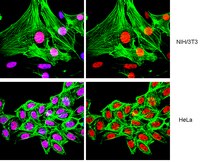Structure of the arginine methyltransferase PRMT5-MEP50 reveals a mechanism for substrate specificity.
Ho, MC; Wilczek, C; Bonanno, JB; Xing, L; Seznec, J; Matsui, T; Carter, LG; Onikubo, T; Kumar, PR; Chan, MK; Brenowitz, M; Cheng, RH; Reimer, U; Almo, SC; Shechter, D
PloS one
8
e57008
2013
Mostrar resumen
The arginine methyltransferase PRMT5-MEP50 is required for embryogenesis and is misregulated in many cancers. PRMT5 targets a wide variety of substrates, including histone proteins involved in specifying an epigenetic code. However, the mechanism by which PRMT5 utilizes MEP50 to discriminate substrates and to specifically methylate target arginines is unclear. To test a model in which MEP50 is critical for substrate recognition and orientation, we determined the crystal structure of Xenopus laevis PRMT5-MEP50 complexed with S-adenosylhomocysteine (SAH). PRMT5-MEP50 forms an unusual tetramer of heterodimers with substantial surface negative charge. MEP50 is required for PRMT5-catalyzed histone H2A and H4 methyltransferase activity and binds substrates independently. The PRMT5 catalytic site is oriented towards the cross-dimer paired MEP50. Histone peptide arrays and solution assays demonstrate that PRMT5-MEP50 activity is inhibited by substrate phosphorylation and enhanced by substrate acetylation. Electron microscopy and reconstruction showed substrate centered on MEP50. These data support a mechanism in which MEP50 binds substrate and stimulates PRMT5 activity modulated by substrate post-translational modifications. | 23451136
 |














